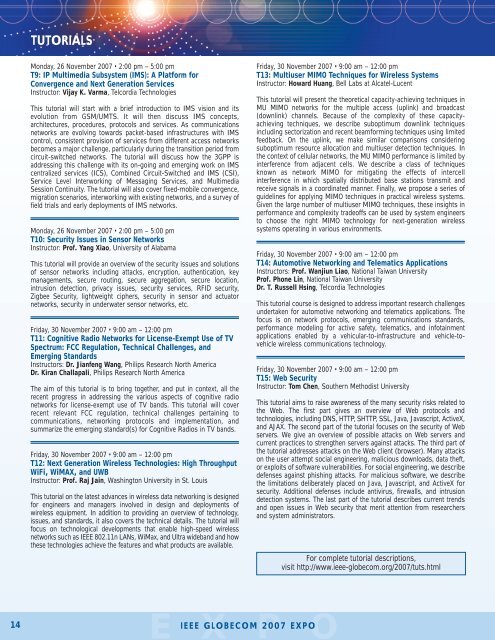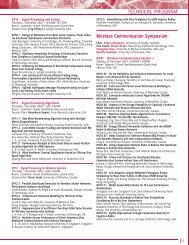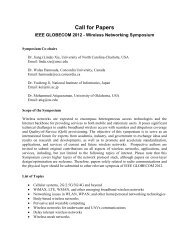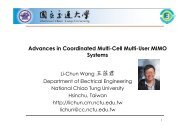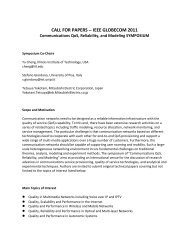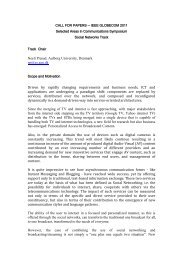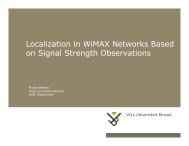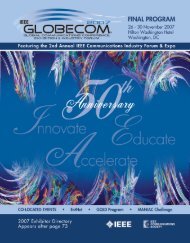information - IEEE GLOBECOM 2013
information - IEEE GLOBECOM 2013
information - IEEE GLOBECOM 2013
Create successful ePaper yourself
Turn your PDF publications into a flip-book with our unique Google optimized e-Paper software.
TUTORIALS<br />
Monday, 26 November 2007 • 2:00 pm – 5:00 pm<br />
T9: IP Multimedia Subsystem (IMS): A Platform for<br />
Convergence and Next Generation Services<br />
Instructor: Vijay K. Varma, Telcordia Technologies<br />
This tutorial will start with a brief introduction to IMS vision and its<br />
evolution from GSM/UMTS. It will then discuss IMS concepts,<br />
architectures, procedures, protocols and services. As communications<br />
networks are evolving towards packet-based infrastructures with IMS<br />
control, consistent provision of services from different access networks<br />
becomes a major challenge, particularly during the transition period from<br />
circuit-switched networks. The tutorial will discuss how the 3GPP is<br />
addressing this challenge with its on-going and emerging work on IMS<br />
centralized services (ICS), Combined Circuit-Switched and IMS (CSI),<br />
Service Level Interworking of Messaging Services, and Multimedia<br />
Session Continuity. The tutorial will also cover fixed-mobile convergence,<br />
migration scenarios, interworking with existing networks, and a survey of<br />
field trials and early deployments of IMS networks.<br />
Monday, 26 November 2007 • 2:00 pm – 5:00 pm<br />
T10: Security Issues in Sensor Networks<br />
Instructor: Prof. Yang Xiao, University of Alabama<br />
This tutorial will provide an overview of the security issues and solutions<br />
of sensor networks including attacks, encryption, authentication, key<br />
managements, secure routing, secure aggregation, secure location,<br />
intrusion detection, privacy issues, security services, RFID security,<br />
Zigbee Security, lightweight ciphers, security in sensor and actuator<br />
networks, security in underwater sensor networks, etc.<br />
Friday, 30 November 2007 • 9:00 am – 12:00 pm<br />
T11: Cognitive Radio Networks for License-Exempt Use of TV<br />
Spectrum: FCC Regulation, Technical Challenges, and<br />
Emerging Standards<br />
Instructors: Dr. Jianfeng Wang, Philips Research North America<br />
Dr. Kiran Challapali, Philips Research North America<br />
The aim of this tutorial is to bring together, and put in context, all the<br />
recent progress in addressing the various aspects of cognitive radio<br />
networks for license-exempt use of TV bands. This tutorial will cover<br />
recent relevant FCC regulation, technical challenges pertaining to<br />
communications, networking protocols and implementation, and<br />
summarize the emerging standard(s) for Cognitive Radios in TV bands.<br />
Friday, 30 November 2007 • 9:00 am – 12:00 pm<br />
T12: Next Generation Wireless Technologies: High Throughput<br />
WiFi, WiMAX, and UWB<br />
Instructor: Prof. Raj Jain, Washington University in St. Louis<br />
This tutorial on the latest advances in wireless data networking is designed<br />
for engineers and managers involved in design and deployments of<br />
wireless equipment. In addition to providing an overview of technology,<br />
issues, and standards, it also covers the technical details. The tutorial will<br />
focus on technological developments that enable high-speed wireless<br />
networks such as <strong>IEEE</strong> 802.11n LANs, WiMax, and Ultra wideband and how<br />
these technologies achieve the features and what products are available.<br />
Friday, 30 November 2007 • 9:00 am – 12:00 pm<br />
T13: Multiuser MIMO Techniques for Wireless Systems<br />
Instructor: Howard Huang, Bell Labs at Alcatel-Lucent<br />
This tutorial will present the theoretical capacity-achieving techniques in<br />
MU MIMO networks for the multiple access (uplink) and broadcast<br />
(downlink) channels. Because of the complexity of these capacityachieving<br />
techniques, we describe suboptimum downlink techniques<br />
including sectorization and recent beamforming techniques using limited<br />
feedback. On the uplink, we make similar comparisons considering<br />
suboptimum resource allocation and multiuser detection techniques. In<br />
the context of cellular networks, the MU MIMO performance is limited by<br />
interference from adjacent cells. We describe a class of techniques<br />
known as network MIMO for mitigating the effects of intercell<br />
interference in which spatially distributed base stations transmit and<br />
receive signals in a coordinated manner. Finally, we propose a series of<br />
guidelines for applying MIMO techniques in practical wireless systems.<br />
Given the large number of multiuser MIMO techniques, these insights in<br />
performance and complexity tradeoffs can be used by system engineers<br />
to choose the right MIMO technology for next-generation wireless<br />
systems operating in various environments.<br />
Friday, 30 November 2007 • 9:00 am – 12:00 pm<br />
T14: Automotive Networking and Telematics Applications<br />
Instructors: Prof. Wanjiun Liao, National Taiwan University<br />
Prof. Phone Lin, National Taiwan University<br />
Dr. T. Russell Hsing, Telcordia Technologies<br />
This tutorial course is designed to address important research challenges<br />
undertaken for automotive networking and telematics applications. The<br />
focus is on network protocols, emerging communications standards,<br />
performance modeling for active safety, telematics, and infotainment<br />
applications enabled by a vehicular-to-infrastructure and vehicle-tovehicle<br />
wireless communications technology.<br />
Friday, 30 November 2007 • 9:00 am – 12:00 pm<br />
T15: Web Security<br />
Instructor: Tom Chen, Southern Methodist University<br />
This tutorial aims to raise awareness of the many security risks related to<br />
the Web. The first part gives an overview of Web protocols and<br />
technologies, including DNS, HTTP, SHTTP, SSL, Java, Javascript, ActiveX,<br />
and AJAX. The second part of the tutorial focuses on the security of Web<br />
servers. We give an overview of possible attacks on Web servers and<br />
current practices to strengthen servers against attacks. The third part of<br />
the tutorial addresses attacks on the Web client (browser). Many attacks<br />
on the user attempt social engineering, malicious downloads, data theft,<br />
or exploits of software vulnerabilities. For social engineering, we describe<br />
defenses against phishing attacks. For malicious software, we describe<br />
the limitations deliberately placed on Java, Javascript, and ActiveX for<br />
security. Additional defenses include antivirus, firewalls, and intrusion<br />
detection systems. The last part of the tutorial describes current trends<br />
and open issues in Web security that merit attention from researchers<br />
and system administrators.<br />
For complete tutorial descriptions,<br />
visit http://www.ieee-globecom.org/2007/tuts.html<br />
14<br />
E X P O<br />
<strong>IEEE</strong> <strong>GLOBECOM</strong> 2007 EXPO


